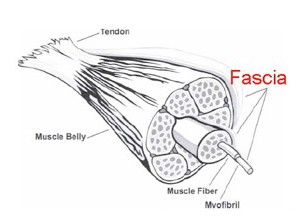You have probably heard the term fascia before, although it may have been in relation to a structure beneath your roofline on your home. However, the term is also used to describe the most pervasive tissue type in the human body.
Fascia is a connective tissue and it surrounds and supports every blood vessel, nerve, muscle, bone, and internal organ in your body. In fact, if you removed every other tissue type but the fascia, the remaining form would still look very much like what you are used to seeing in terms of the shape of a human body.
Integrated Neuromuscular and Myofascial Technique (I-NMT) is a foundation of our practice here at Hands On Health, and as you can see, fascia is integral to this technique in both the title and our method of soft tissue manipulation.
Fascia has several properties that make it important to what we do, and also important to how your body is functioning and feeling. With heat and energy, the fascia shifts from a thicker (gel) substance to a less viscous liquid (sol) substance. This property is called thixotropy. Due to its structural makeup, fascia is also affected by your level of hydration. Without enough water in your systems, your fascia can become increasingly viscous and firm. Finally, fascia is also defined by its plasticity – if you stretch it slow it will deform, change, and maintain length. Stretch it too fast and it will tear.
Like muscle, fascia is affected by your physical activities and postural habits. When your shoulder joint becomes medially rotated, if you adopt a head forward position, or your hips take on an anterior tilt, both muscle and fascia become accustomed to that position.
Frequently, when your therapist begins to work on your affected areas, they will warm the tissue and fascia to take advantage of its thixotropic nature. This allows increased circulation, (which oxygenates the tissues and removes wastes), as well as opening the area to greater access for manual manipulation due to the more liquid state of the fascia.
After treating the affected muscles to ease tension and reduce pain, your therapist will likely explain how your posture is negatively affecting you. Just remember in the future, that the tightness you are feeling is not just your muscular tissue, but also your fascial tissue!
To learn more about fascia and its role in your body, please check out the following links:

